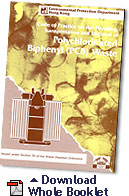Code of Practice on the Handling, Transportation and Disposal of Polychlorinated Biphenyl (PCB) Waste
Preface
Polychlorinated biphenyls (PCBs) were used extensively in the past as dielectric fluids for applications in electrical capacitors and transformers. Increasing concern over their health hazards and adverse environmental effects has resulted in their diminishing use and gradual replacement, and in some countries a complete ban. Under the Waste Disposal (Chemical Waste) (General) Regulation, polychlorinated biphenyl waste is classifiable as chemical waste and its handling, collection, transportation and disposal is controlled by the legislation. This code gives guidance to persons who may come into contact with polychlorinated biphenyl waste on its safe handling and how they can comply with the legislative controls.
This Code of practice is a statutory document. It was first published in December 1992 by the Secretary for Planning, Environment and Lands under Section 35 of the Waste Disposal Ordinance after consultation with the Environmental Pollution Advisory Committee. The purpose of this Code of practice is to provide guidance and advice on the collection, storage, treatment, transportation and disposal of waste. It is not legally binding, but compliance with the Code could be employed as evidence of good practice in the course of a legal defence.
Enquires concerning the chemical waste control scheme, including the Code of Practice and the Regulation, can be addressed to the Regional Offices of the Environmental Protection Department.

